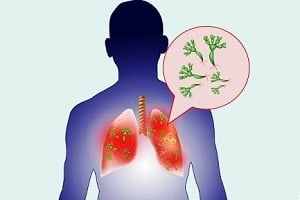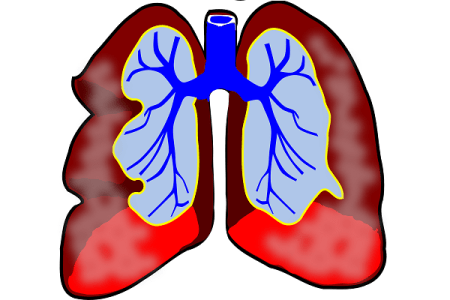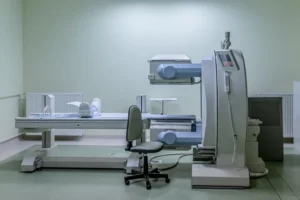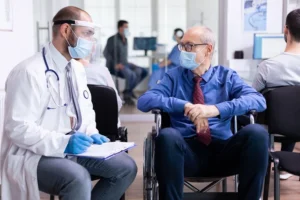Lung Cancer: Symptoms, Causes, Diagnosis, Treatment
- Updated on: Jul 5, 2024
- 6 min Read
- Published on Apr 21, 2021

What is a Lung Cancer?
Like all other types of cancers, lung cancer develops due to an abnormality in the cells of the body. Normally, the body keeps a balance on cell growth so that body cells divide to produce new cells only when new cells are needed. An uncontrolled cell growth and division of cells forms a mass called tumor.
In principle, cancer can occur in any part of the body. Lung cancer is a cancer that starts in the lungs.
How common is lung cancer?
Lung cancer is one of the most common and serious types of cancer. About 44,500 people are diagnosed with the disease lung cancer every year in the United Kingdom. According to data from the American Cancer Society, in 2016, about 224,000 new cases of lung cancer in the U.S. occurred and over 158,000 deaths were due to the disease. According to the U.S. National Cancer Institute, about 6.5% of men and women in the U.S. will be diagnosed with cancer of the lung sometime in their life.
Lung cancer is the most common cause of death due to cancer in both men and women throughout the world. There are more deaths due to lung cancer than the number of deaths occurring due to colon and rectal, breast, and prostate cancer combined.
What are the signs and symptoms of lung cancer?
The symptoms of lung cancer vary depending on the location and size of the tumor. It is not always easy to identify lung cancer in the initial stages. Lung cancer may not always cause pain or other warning signs. If symptoms appear, these may include:
- worsening cough
- phlegm or blood in cough
- pain in chest that worsens when you breathe deeply, laugh, or cough
- hoarse voice
- fatigue and general weakness
- unexplained weight loss
- loss of appetite
- respiratory infections such as pneumonia or bronchitis
- shortness of breath
- wheezing
- bone pain
- headache
If the lung cancer spreads to nearby organs, additional symptoms such as the following may develop.
- headache, dizziness, balance problems, or numbness in arms or legs may happen if the cancer spreads to brain
- jaundice: yellowing of skin may occur of the cancer spreads to liver. Read about liver cancer
- pain in bone, ribs, and back may occur of the cancer spreads to bones
- the cancer may spread to lymph nodes, symptoms such as lumps may be noted
What are the causes of lung cancer? Are you at risk of developing lung cancer?
Smoking
Smoking is the leading cause of lung cancer. Though anyone can get lung cancer, but 90 percent of lung cancer cases occur due to smoking.
How does smoking causes lung cancer?
The moment you start smoking and smoke enters into your lungs, it starts damaging the tissues of your lungs. The lungs can repair the damage, but if the damage continues for a long time, it becomes difficult for the lungs to repair the damage. When the cells are damaged and they begin to behave abnormally, the likelihood of developing lung cancer increases. As soon as smoking stops, the risk of lung cancer starts decreasing over time.
Other causes of lung cancer
- Exposure to radon, a naturally existing radioactive gas, is the second leading cause, according to the American Lung Association.
Breathing in hazardous substances
Breathing in certain substances such as asbestos, particularly over a long period of time, can cause lung cancer. Other substances that can cause cancer of the lung are:
- arsenic
- nickel
- certain petroleum products
- cadmium
- chromium
- uranium
- diesel exhaust
You must seek treatment if you have been exposed to any of these substances for prolonged periods. In the case of asbestos, it can take many years for symptoms to show, so talking to a Mesothelioma Lawyer, for example, can help you understand your options if you are diagnosed with Mesothelioma.
Inherited genetic mutations
While most cases of lung cancers are associated with tobacco smoking, but not all smokers eventually develop lung cancer. Individual genetic susceptibility may play a role in the development and causation of lung cancer. Several studies have shown that lung cancer is more likely to occur in relatives of both smoking and nonsmoking people. People who inherit certain genes may be at greater risk for lung cancer.
Presence of certain lung disease
Certain diseases of the lung such as chronic obstructive pulmonary disease (COPD) are associated with an increased risk of lung cancer. Pulmonary fibrosis also appears to increase the risk of cancer of the lung.
Prior history of lung cancer
People who have had lung cancer earlier are at higher risk of developing a second lung cancer than the general population.
Air pollution
Air pollution from vehicles and industry can increase the chances of developing lung cancer in certain individuals. According to estimates, about 1%-2% of lung cancer deaths are attributed to pollution of the air.
How is lung cancer diagnosed?
Your doctor will first perform a physical examination and review your medical history and family history. He or she will then order one more of the following tests to perform diagnosis of lung cancer.
Tests for diagnosing lung cancer
Imaging tests: chest X-ray, MRI, CT, and PET scans provide detailed images of tissues and the tumors.
Sputum cytology: Microscopic examination of phlegm can identify if cancer cells are present.
Bronchoscopy: A small tube with light is passed down the throat and into the lungs to allow examination of the lungs.
Biopsy: A sample of cancerous cells is taken and analyzed in the lab. This is called biopsy.
Endoscopic ultrasound: Endoscopic ultrasound of an abnormal mass may also be performed at the time of bronchoscopy.
Thoracentesis: Sometimes lung cancers involve the lining tissue of the lungs and cause accumulation of fluid in the region between the lungs and chest wall. Aspiration of a small sample of this fluid may help identify the cancer cells.
Blood tests: Routine blood tests alone cannot diagnose lung cancer, but they may help determine biochemical or metabolic abnormalities in the body that are linked to cancer. For example, increased levels of calcium or of alkaline phosphatase may be associated with cancer.
What is the treatment of lung cancer?
The treatment of lung cancer mainly involves removal of the cancer surgically, chemotherapy, radiation therapy, and a combination thereof. Sometimes, targeted therapies and immunotherapy are also used along with these options. Your doctor will make a decision about which treatments will be appropriate for you based on the location and extent of the tumor and the overall health status of the patient.
Surgery
Surgical removal of the tumor is the treatment of choice for cancer that has not spread beyond the lung. About 10%-35% of lung cancers can be removed surgically, but removal does not always completely cure the disease. The tumors can recur at a later time.
Surgery may not be suitable for everyone. It is not possible to perform surgery if the person has other serious conditions, such as chronic heart or lung disease. Surgery is less often performed with small-cell lung cancer (SCLC) than with non-small cell lung cancer (NSCLC) because these tumors are less likely to be localized to one area that can be removed. If the cancer has spread to other organs and is not localized, surgery may not be a suitable option.
The surgical procedure your doctor will choose depends upon the size and location of the tumor. In the procedure, surgeons open the chest wall and perform a resection of the lung (removal of a portion of one lobe), or a lobectomy (removal of one lobe), or a pneumonectomy (removal of an entire lung). Lymph nodes may also be removed in some cases around the region of the lungs. This procedure is called lymphadenectomy.
Lung cancer surgery is a major procedure. It is done under general anesthesia and requires hospitalization and follow-up care for a few months.
Radiation therapy
Radiation therapy may be considered for the treatment of both NSCLC and SCLC. This therapy uses high-energy beams such as X-rays or other types of radiation to kill the abnormal cancer cells.
Radiation therapy may be given in combination with surgery or chemotherapy or other treatment options. The radiation is either delivered externally by using a machine that directs radiation toward the cancer or internally through implant of radioactive substances in the area of the body where the tumor is localized.
Brachytherapy is a technique that involves the use of a small pellet of radioactive material placed directly into the cancer or into the airway next to the cancer. This is usually done through a device called bronchoscope.
Chemotherapy
Both types of cancers, NSCLC and SCLC, may be treated with chemotherapy. Chemotherapy involves delivery of drugs to stop the growth of cancer cells by killing them or preventing them from dividing intravenously. Chemotherapy may be given alone, as an adjuvant to surgical therapy, or in combination with other treatment option such as radiotherapy.
Targeted therapy
Targeted therapy involves the use of drugs to target abnormalities of a tumor that are vulnerable. Erlotinib (Tarceva) and gefitinib (Iressa) are targeted drugs that more specifically target cancer cells causing less damage to normal cells than general chemotherapeutic agents. Erlotinib and gefitinib are drugs to target a protein called epidermal growth factor receptor that is important in promoting the division of cells.
Targeted therapy works by interfering with specific abnormalities of a tumor. It has been shown to slow or stop advanced cancer cells from advancing for a few months longer than with no treatment.
Immunotherapy
Immunotherapy may be effective for some patients with advanced lung cancers. The therapy works by strengthening the activity of the immune system against tumor cells. Examples of drugs used in immunotherapy are nivolumab (Opdivo) and pembrolizumab (Keytruda). These were approved by the U.S. FDA in 2015 for the treatment of lung cancer.
Radiofrequency ablation (RFA)
Radiofrequency ablation involves insertion of a needle through the skin into the cancer under the guidance of CT scanning. Electrical energy, for example, is transmitted to the tip of the needle to produce heat in the tissues causing the killing of the cancerous tissue and blocking tiny blood vessels that supply blood to the cancer cells.
RFA is usually not painful and has been approved by the FDA for the treatment of certain cancers, including lung cancers.












